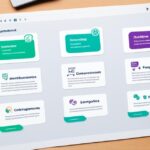Table of Contents
In the fast-paced digital age, user experience (UX) is crucial for the success of software applications. Usability testing and user-centric testing play a pivotal role in creating exceptional user experiences. Usability testing evaluates the ease of interaction with a software application, identifies usability issues, and collects user feedback. User-centric testing goes a step further by considering the overall user experience, including emotional and psychological factors. Both types of testing lead to improved usability, enhanced user satisfaction, reduced development costs, increased market share, and brand loyalty.
Understanding Usability Testing
Usability testing plays a vital role in evaluating the ease of interaction with a software application. By conducting usability testing, developers can identify and address usability issues, ensuring a seamless user experience. This section will delve into the key aspects of usability testing, including task analysis, user feedback, the iterative process, test participants, a moderator, the test environment, tasks and scenarios, data collection, and iteration.
Task Analysis
Task analysis is an essential component of usability testing. It involves breaking down complex actions into smaller, more manageable tasks to evaluate the usability of a software application. By analyzing tasks, developers can understand the user’s perspective and design interfaces that cater to user needs and preferences.
User Feedback
User feedback provides valuable insights into the user experience. During usability testing, users are encouraged to share their thoughts, frustrations, and suggestions. This feedback helps developers identify pain points and areas for improvement, enabling them to refine the user interface.
The Iterative Process
Usability testing follows an iterative process, where feedback is continuously gathered and incorporated into the design. This allows developers to refine the software application over multiple iterations, ensuring optimal usability and user satisfaction.
Test Participants and Moderator
Test participants represent the target audience of the software application. They perform specific tasks in a controlled environment while a moderator guides them through the testing process. Test participants’ actions, frustrations, and feedback are observed and recorded to gain valuable insights for improving usability.
Test Environment
A controlled test environment is essential for accurate usability testing. It eliminates external distractions and variables that may influence the user’s interaction with the software application. The environment should mimic the user’s natural setting as closely as possible to obtain authentic user feedback.
Tasks and Scenarios
During usability testing, participants are assigned specific tasks and scenarios to complete. These tasks are carefully designed to mimic real-life user interactions with the software application. By observing how participants navigate through the tasks, developers can identify usability issues and make informed design decisions.
Data Collection
Data collection during usability testing involves recording participants’ actions, feedback, and observations. This data provides valuable insights into the user experience, allowing developers to make data-driven decisions when refining the design.
Iteration
The iterative nature of usability testing allows for continuous improvement. Developers use the collected data and insights from each iteration to refine the design and address usability issues. This iterative process ensures that the software application becomes increasingly user-friendly and aligned with user expectations.
By understanding the core principles and components of usability testing, developers can create software applications that provide exceptional user experiences. The insights gained through usability testing drive informed design decisions, resulting in user-friendly interfaces that meet user needs and preferences.
Exploring User-Centric Testing
User-centric testing goes beyond usability and focuses on the overall user experience. It takes into account emotional and psychological factors, adopting a holistic perspective of the user journey. By considering both qualitative and quantitative data, user-centric testing aims to understand users’ emotional responses and tailor the experience to their needs and preferences. This approach leads to enhanced user satisfaction and fosters brand loyalty.
One key strategy in user-centric testing is the creation of user personas. User personas represent the characteristics, behaviors, and preferences of the target audience, providing valuable insights for designing a user-centered experience. By analyzing user personas, developers gain a deeper understanding of their users, allowing them to develop software applications that are specifically tailored to meet their needs.
Qualitative and Quantitative Data
User-centric testing relies on both qualitative and quantitative data to gain a comprehensive understanding of the user experience. Qualitative data offers insights into users’ thoughts, emotions, and perceptions, allowing developers to identify pain points, uncover underlying motivations, and discover potential areas for improvement.
Qualitative data provides valuable context and depth, allowing us to understand the “why” behind user behavior.
On the other hand, quantitative data provides statistical evidence and measurable metrics that can help identify trends, patterns, and areas of improvement. This data is collected through surveys, analytics tools, and user testing software. By combining both qualitative and quantitative data, developers can make informed decisions about the user experience, ensuring they are meeting user expectations and designing user-friendly software applications.
The Holistic Perspective
A key aspect of user-centric testing is adopting a holistic perspective of the user journey. This means considering all touchpoints and interactions users have with a software application, from the first point of contact to the final stage of interaction.
Understanding the user journey allows us to identify areas of friction, improve user satisfaction, and create a seamless experience.
By mapping out the user journey, developers can identify pain points, optimize user flows, and ensure that the overall experience aligns with user expectations and goals. This holistic perspective enables developers to create software applications that not only meet functional needs but also address the emotional and psychological aspects of the user experience.
Enhancing User Satisfaction and Brand Loyalty
By focusing on the overall user experience and addressing emotional and psychological factors, user-centric testing leads to improved user satisfaction. When users feel understood, valued, and catered to, they are more likely to form positive associations with a software application and develop brand loyalty.
This user-centric approach also fosters positive word-of-mouth, as satisfied users are more likely to recommend the software application to others. This word-of-mouth marketing can contribute to increased market share and organic growth.
Summary
User-centric testing is a comprehensive approach that goes beyond usability and focuses on the overall user experience. By considering emotional and psychological factors, relying on qualitative and quantitative data, and adopting a holistic perspective, developers can create software applications that delight users, improve user satisfaction, and foster brand loyalty.
Benefits of Usability Testing and User-Centric Testing
Usability testing and user-centric testing bring forth a myriad of advantages for software development. By evaluating the ease of interaction with a software application, usability testing aids in identifying and resolving usability issues, resulting in a more user-friendly product. On the other hand, user-centric testing takes the evaluation a step further, focusing on delighting users and fostering higher overall satisfaction.
Usability testing helps ensure improved usability, enhanced user satisfaction, and reduced development costs by addressing issues early in the design process.
When usability is prioritized, it attracts and retains more users, directly contributing to increased market share for software products. Moreover, positive user experiences foster brand loyalty and advocacy, consolidating customer trust and engagement.
Improved Usability and Enhanced User Satisfaction
Usability testing plays a vital role in enhancing the usability of software applications. By identifying and resolving usability issues early in the development process, it ensures that users can easily interact with the application and perform desired tasks without frustration or confusion. As a result, users are more satisfied with the software’s performance and usability, leading to increased adoption and usage.
Addressing usability issues and incorporating user feedback during the testing phase significantly reduces the overall development costs. By identifying and rectifying usability issues early on, developers can avoid costly redesigns and redevelopments at later stages of the software development lifecycle. This proactive approach not only saves time but also prevents potential revenue loss.
Moreover, emphasizing user experience through usability testing and user-centric testing positively impacts market share. When software applications are user-friendly and provide a seamless experience, users are more likely to choose and recommend them over competing products. This increase in market share translates into greater opportunities for growth and success in the highly competitive software market.
Brand Loyalty and Advocacy
Usability testing and user-centric testing not only contribute to improved usability and user satisfaction but also foster brand loyalty and advocacy. When users have positive experiences with a software application, they develop a sense of trust and loyalty towards the brand. This loyalty encourages them to continue using the software and even advocate for it among their peers and networks.
Brand loyalty and advocacy create a ripple effect, attracting new users and expanding the customer base. The positive word-of-mouth and recommendations from satisfied users contribute to the long-term success and sustainability of the brand.
Overall, usability testing and user-centric testing are indispensable components in the software development process. By ensuring improved usability, enhanced user satisfaction, reduced development costs, increased market share, and brand loyalty, these testing methods pave the way for exceptional user experiences and long-term success in the competitive digital landscape.
The Fundamentals of a Great User Experience
User experience is a key factor in the success of any digital platform. To ensure an exceptional user experience, various elements must be considered, including web design and visuals, functionality, content, performance, and accessibility. Let’s explore each of these components and understand their importance in creating a great user experience.
Web Design and Visuals
A visually appealing and well-designed website or app creates a positive first impression and engages users. Design elements such as visual hierarchy, colors, typography, and the use of white space play a crucial role in guiding users through the interface. A well-designed platform enhances usability and establishes credibility.
Functionality
Functionality refers to how smoothly users can navigate and interact with the platform. It encompasses features like responsive design, intuitive navigation menus, and interactive elements. Users should be able to easily perform tasks and access desired information without confusion or frustration. A seamless and user-friendly functionality enhances the overall experience.
Content
Compelling and relevant content is essential for keeping users engaged and informed. Content should be clear, concise, readable, and presented in a well-structured manner. Good content provides value to users, answers their questions, and guides them through the platform effectively. Additionally, content should be tailored to the target audience to ensure maximum impact.
Performance
The performance of a website or app greatly impacts the user experience. Users expect fast loading times and smooth interactions. Slow load times, laggy animations, or unresponsive buttons can frustrate users and lead to higher bounce rates. Optimizing performance by minimizing page load times and ensuring smooth functionality is crucial for a great user experience.
Accessibility
Ensuring accessibility means making the platform usable for users with diverse abilities. This includes utilizing appropriate color contrasts, providing alternative text for images, using screen reader-friendly elements, and implementing keyboard navigation. By removing barriers and making the platform accessible to everyone, you can create an inclusive user experience.
Now that we have explored the fundamentals of a great user experience, it is clear that a combination of web design, functionality, content, performance, and accessibility is crucial for creating exceptional digital platforms. By focusing on these aspects, you can ensure a positive user experience that keeps users engaged, satisfied, and eager to return.
Dos to Improve User Experience
Improving user experience (UX) is crucial for the success of any website or application. By implementing the following best practices, you can create a seamless and enjoyable user journey.
1. Conduct User Research
Before designing or revamping your platform, it’s essential to understand your users’ preferences and needs. Conducting user research helps uncover valuable insights that can inform your design decisions and ensure that your website or app meets user expectations.
2. Implement Responsive Design
In today’s mobile-first world, responsive design is a must. Optimizing your website or app for different devices ensures that users can access your content easily, regardless of their screen size. This approach enhances user experience and helps you reach a wider audience.
Intuitive navigation is key to creating a user-friendly interface. Ensure that your website or app is easy to navigate, with clear and well-organized menus and navigation bars. Users should be able to find the information or functionality they’re looking for effortlessly.
4. Create Engaging Content
Engaging content is essential to capture and retain users’ attention. Utilize storytelling techniques, personalize the user experience, and incorporate interactive elements to make your content more compelling. This approach not only enhances user engagement but also increases the chances of conversion.
5. Optimize Page-Load Speed
Page-load speed significantly impacts user experience. Slow-loading pages frustrate users and increase the likelihood of them leaving your site. Implement strategies such as optimizing images, reducing server response time, and minifying code to improve page-load speed and keep users engaged.
6. Ensure Site Accessibility
Site accessibility is crucial to ensure that all users, including those with disabilities, can access and use your platform effectively. Incorporate features such as alternative text for images and keyboard navigation to make your website or app more inclusive and user-friendly.
By following these dos, you can create a user experience that is optimized for usability, engagement, and accessibility. Prioritizing user experience leads to higher user satisfaction, increased conversions, and ultimately, business success.
Don’ts for Improving User Experience
When it comes to improving user experience, there are certain pitfalls that should be avoided. Neglecting user feedback, inconsistent branding, and ignoring data analysis can hinder the success of your website or app. To create a seamless user experience, it is crucial to consider these factors.
Neglecting User Feedback
Actively listening to user feedback is key to enhancing the user experience. Reviews, comments, and suggestions provide valuable insights into the needs and preferences of your users. By neglecting this valuable feedback, you risk overlooking important areas for improvement and may fail to address issues that could negatively impact user satisfaction.
Inconsistent Branding
Consistent branding is essential for creating a cohesive user experience. Inconsistencies in branding elements such as colors, fonts, and imagery can confuse users and erode trust in your brand. It is important to maintain a consistent visual identity across all pages and touchpoints to reinforce brand recognition and create a seamless experience for users.
Ignoring Data Analysis
Data analysis from user testing tools provides valuable insights into user behavior and preferences. By ignoring this data, you miss out on important information that can guide improvements in content design and the overall user experience. Data analysis helps identify trends, pain points, and areas of success, enabling you to make informed decisions that will enhance user satisfaction and drive engagement.
By avoiding these don’ts and instead embracing user feedback, consistent branding, and data analysis, you can create an exceptional user experience that delights your users and builds long-lasting brand loyalty.
Conclusion
Usability testing and user-centric testing are vital aspects of UX design that greatly contribute to the success of software development. By incorporating these methodologies into the development process, developers can create user-friendly products that cater to the needs and preferences of users. This ultimately leads to higher levels of user satisfaction, increased market share, and stronger brand loyalty.
The future of software development is moving towards a more user-centric approach, where understanding and empathizing with users are paramount. User testing software plays a crucial role in this user-centric future, enabling developers to gather valuable insights and feedback directly from the users. This ensures that the end product not only meets the functional requirements but also provides an exceptional user experience.
As technology evolves and user expectations continue to rise, UX design and user testing software will remain crucial components in creating successful software applications. Investing in UX design and user-centric testing not only benefits users but also yields long-term advantages for businesses, including reduced development costs and increased market competitiveness. In this user-centric future, companies that prioritize the user experience will thrive and maintain a competitive edge in the software development industry.
FAQ
What is usability testing?
Usability testing evaluates the ease of interaction with a software application, identifies usability issues, and collects user feedback.
How does usability testing work?
Usability testing involves designing specific tasks for users to perform and observing their actions, frustrations, and feedback. Test participants, who represent the target audience, perform tasks in a controlled environment while a moderator guides them.
What is user-centric testing?
User-centric testing goes beyond usability and focuses on the overall user experience. It considers emotional and psychological factors, taking a holistic perspective of the user journey.
What methods does user-centric testing rely on?
User-centric testing relies on qualitative and quantitative data and often involves creating user personas. It aims to understand users’ emotional responses and tailor the experience to their needs and preferences.
What are the benefits of usability testing and user-centric testing?
Usability testing helps identify and fix usability issues, resulting in a more user-friendly product. User-centric testing goes beyond usability to focus on delighting users and leads to higher overall satisfaction. Both types of testing can save development costs in the long run by addressing issues early. Prioritizing user experience attracts and retains more users, leading to increased market share. Positive user experiences foster brand loyalty and advocacy.
What does a great user experience entail?
A great user experience encompasses various aspects, including web design and visuals, functionality, content, performance, and accessibility. It involves visual hierarchy, use of white space, and overall aesthetics for good web design and visuals. Functionality refers to how smoothly the platform works, including responsiveness and navigation. Content needs to be relevant, clear, concise, and readable. Performance refers to the load times and speed of the website or app. Accessibility ensures that users with diverse abilities can access and use the platform effectively.
How can user experience be improved?
To improve user experience, it is recommended to conduct user research to understand user preferences and needs. Implement responsive design and mobile optimization to cater to users on different devices. Focus on intuitive navigation and keep the design clean and organized. Create engaging content through storytelling, personalization, and interactive elements. Optimize page-load speed to prevent users from bouncing away. Make your site accessible to users with disabilities by incorporating features like alternative text and keyboard navigation.
What should be avoided when improving user experience?
When improving user experience, it is important to not neglect user feedback. Actively listen to reviews, comments, and suggestions from users to enhance the user experience. Avoid inconsistent branding elements across your website or app to maintain a cohesive design. Don’t ignore data analysis from user testing tools, as it provides valuable insights for improving the content design and user experience.
Why are usability testing and user-centric testing essential?
Usability testing and user-centric testing are essential components of UX design. By incorporating these methodologies into the software development process, developers can create user-friendly products that align with users’ needs and preferences. This leads to higher user satisfaction, increased market share, and brand loyalty. The future of software development is becoming more user-centric, emphasizing the importance of understanding and empathizing with users.













